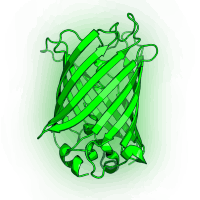Development of “Smart” Fluorescent Probes
We design new fluorophores based on fluorescent proteins, focusing especially on fluorophores with properties that can be changed through irradiation with light. Rather whimsically we like to call these “smart” fluorophores. We then study their properties and apply these in advanced fluorescence imaging.
The new fluorophores we design are enhanced or modified version of existing fluorescent proteins. The resulting fluorophores include both rational mutations, and mutations developed using directed evolution.
Our aim in this research is both to develop useful tools for imaging, but also to develop a fundamental understanding of the mechanisms underlying the “smart” behaviors responsible for their usefulness.
Improved Fluorescence Imaging
We have a strong interest in fluorescence imaging. In particular we are interested in finding good or even optimal ways to extract more information from the imaging or to image under “difficult” conditions, such as low signal-to-noise ratio, or of fast processes occurring at very small spatial length scales.
One of our main topics recently is the development of stochastic optical fluctuation imaging (SOFI). In SOFI, we make use of spontaneous fluctuations of the fluorophore emission. Since the fluorophore emission is dynamic, we can acquire many complementary images from the same sample and combine these to obtain a single information-enhanced image with a sub-diffraction spatial resolution.
We are particularly interested in SOFI imaging due to the technique’s robustness compared to other sub-diffraction imaging techniques. In particular, SOFI imaging does not require that fluorophores are individually resolvable, nor does it require that the excitation light is precisely distributed along a known pattern.
Biosensors
We are also interested in developing fluorescent reporters that combine “smart” photophysical behavior with sensing of the molecular environment. For example, we have recently developed a bimolecular fluorescence complementation (BiFC) pair based on the photochromic fluorescent protein Dronpa. Using this probe we can investigate molecular interactions inside the live system with a sub-diffraction spatial resolution. Currently we are also expanding this to the direct sensing of enzymatic activities.



